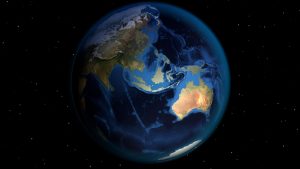The recent declassification of a sensitive national security document by the Trump administration revealed a U.S. strategy in the Indo-Pacific focused on “maintaining U.S. strategic primacy,” countering “Chinese predatory economic practices,” preventing China from establishing “illiberal spheres of influence” with the support of Australia, Japan, and South Korea, and accelerating “India’s rise as a major defense partner” so that it can “act as a counterbalance to China.”
The 10-page document, titled “U.S. Strategic Framework for the Indo-Pacific,” formally classified as SECRET and not for release to foreign nationals, was compiled in 2018 and was expected to remain classified until 2043. The Trump administration released the document late on January 13, potentially in an attempt to regain some form of authority amid the political turmoil in Washington, or perhaps the document was released by senior officials with the aim of encouraging the incoming administration to stay engaged in the Indo-Pacific region.
In any case, the report proves that behind the posturing of U.S. President Donald Trump, there are in policy professionals pursuing a more serious agenda.
The reason for its release aside, as Rory Medcalf, head of the National Security College at the Australian National University, noted the document will “be of long-term interest and warrant close reading…There’s plenty to report and debate in almost every line.”
Australia is noted in the document not nearly as often as Japan, South Korea, or India, but that likely underscores the already secure relations between the two countries. In fact, China has tagged Australia as “America’s deputy sheriff.”
While Australia may be viewed as America’s sidekick, the authors of the U.S. document appear to have taken advice from earlier Australian reports and policy decisions, including Australia’s decision to ban Chinese participation in the rollout of 5G and on legislation countering Chinese foreign interference operations.
Washington sources familiar with the development of the strategy told ABC’s 730 program, which received a leak of the document before it was officially released, that the White House was closely watching what Australia was doing in the region and “incorporated lessons directly from [former Prime Minister Malcolm] Turnbull and his ministers into the strategy.”
“One compelling conclusion we can draw from this strategic framework is that it’s an alliance-driven strategy,” said Medcalf. “In some ways, the strategy is a vision of American fellowship, rather than American leadership.”
The document details how the U.S. sought to “create a quadrilateral security framework with India, Japan, Australia, and the United States” and “deepen trilateral cooperation with Japan and Australia.”
On this, the Trump administration succeeded. Last November, Australia, for the first time since 2007, participated in the annual Malabar naval exercise, alongside the U.S., India, and Japan. Overall, India, Japan, Australia, and the United States have become increasingly important economic and security partners in recent years.
On many other objectives noted in the document, however, the Trump administration has failed. For one, the document states the importance of Southeast Asia, yet Trump routinely snubbed ASEAN summits. In 2019, many ASEAN leaders boycotted meetings with the United States after Trump sent a low-level delegation in his place.
On the Trans-Pacific Partnership, which would have been the largest trade deal in the world, Trump withdrew the U.S., despite months of painstaking efforts by ASEAN leaders. Singapore’s Prime Minister Lee Hsian Loong rhetorically asked Trump at the time, “How can anyone believe in you anymore?” Trump also threatened to withdraw troops from Japan and South Korea and routinely threatened trade action against regional allies that had trade surpluses with the United States.
For Australia, the Trump administration’s efforts in the Indo-Pacific have led to some wins and losses. While Australia was undoubtedly blindsided by Trump’s approach to international institutions and his disregard for regional allies, Australia can be thankful for the Trump administration placing special emphasis on Oceania, Australia’s backyard. Under Trump, the National Security Council appointed its first-ever director for Oceania Affairs, while high-level meetings were held between U.S. officials and leaders of Pacific Island nations, such as Micronesia and Palau.
Another objective for the United States, according to the document, was to “strengthen the capabilities of Australia” to counter “China’s economic aggression,” but Trump’s assault on the World Trade Organization (WTO) undermined Australia’s ability to do just that.
Australia is currently facing a broad economic assault from China, its largest trade partner, including tariffs on Australian wine, beef, sugar, and timber imports and halted imports of Australian coal. The sanctions have so far affected one-third of all Australian exports to China.
Australia sought to take the issue to the WTO, but the U.S. has shut down the disputes settlement mechanism by continually blocking new judges from joining the WTO’s Appellate Body, which would ordinarily deal with the China-Australia dispute. The U.S. has also sought to block the appointment of a new WTO director-general.
Former Australian Prime Minister Turnbull said the document was a “very clear-eyed thoughtful statement of America’s strategic priorities in the Indo-Pacific” but was “not always consistently followed through by President Trump, who was a very erratic operator on the international stage.”
One of the truly bipartisan views held in Washington is concern about an increasingly powerful China. Therefore, it’s expected that the Indo-Pacific may be one of the few areas of policy where the Biden administration does not stray too far from Trump’s own efforts. So, with the U.S. Indo-Pacific strategy closely resembling Australia’s own foreign policy, Australia can only hope that the incoming administration follows the blueprint more closely than the outgoing and with fewer disruptions along the way.

































